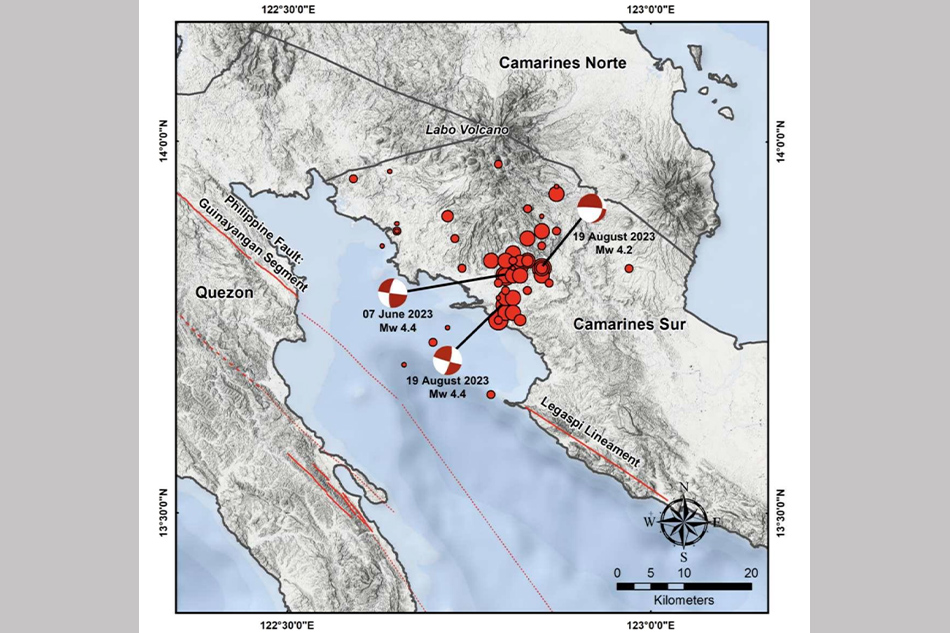Earthquake swarm in CamSur town may be 'precursor' to stronger tremor: Phivolcs
ADVERTISEMENT

Welcome, Kapamilya! We use cookies to improve your browsing experience. Continuing to use this site means you agree to our use of cookies. Tell me more!
Earthquake swarm in CamSur town may be 'precursor' to stronger tremor: Phivolcs
Rowegie Abanto,
ABS-CBN News
Published Aug 23, 2023 05:42 PM PHT
MANILA — An ongoing earthquake swarm in Ragay town, Camarines Sur may be an indication of a stronger tremor, the Philippine Institute of Volcanology and Seismology (Phivolcs) has warned.
MANILA — An ongoing earthquake swarm in Ragay town, Camarines Sur may be an indication of a stronger tremor, the Philippine Institute of Volcanology and Seismology (Phivolcs) has warned.
An earthquake swarm is a short-lived sequence of minor to light temblors, which has no identifiable large event or main shock, according to Phivolcs.
An earthquake swarm is a short-lived sequence of minor to light temblors, which has no identifiable large event or main shock, according to Phivolcs.
In its Aug. 22 primer, the seismology agency said Ragay started experiencing an earthquake swarm on June 7. Over a nearly 5-day period from Saturday until Wednesday afternoon, there were 121 earthquakes recorded in the swarm, 42 of which were felt, ranging from magnitude 1.6 to 4.4, Phivolcs said Wednesday.
In its Aug. 22 primer, the seismology agency said Ragay started experiencing an earthquake swarm on June 7. Over a nearly 5-day period from Saturday until Wednesday afternoon, there were 121 earthquakes recorded in the swarm, 42 of which were felt, ranging from magnitude 1.6 to 4.4, Phivolcs said Wednesday.
The swarm could persist for a few days and disappear over time, Phivolcs noted. But another possibility, it warned, is that the quakes could "be a precursor to a larger magnitude earthquake."
The swarm could persist for a few days and disappear over time, Phivolcs noted. But another possibility, it warned, is that the quakes could "be a precursor to a larger magnitude earthquake."
ADVERTISEMENT
Phivolcs said that earthquake-induced landslides, rock falls, and other types of mass movement could occur in mountainous or hilly areas of Ragay town, home to almost 60,000 people, during the swarm.
Phivolcs said that earthquake-induced landslides, rock falls, and other types of mass movement could occur in mountainous or hilly areas of Ragay town, home to almost 60,000 people, during the swarm.
"Liquefaction, manifested by subsidence, ground fissures, sand boils, and/or lateral spreads may affect low-lying, water-saturated, and sandy areas near water bodies," it said.
"Liquefaction, manifested by subsidence, ground fissures, sand boils, and/or lateral spreads may affect low-lying, water-saturated, and sandy areas near water bodies," it said.
Phivolcs described Camarines Sur as a "seismically active region" due to its active faults, such as the Legaspi Lineament and offshore segments of the Philippine Fault in Ragay Gulf.
Phivolcs described Camarines Sur as a "seismically active region" due to its active faults, such as the Legaspi Lineament and offshore segments of the Philippine Fault in Ragay Gulf.
"Other local faults in close proximity might exist, and some of them could potentially be concealed by recent geologic deposits," it said. "These concealed faults have the potential to generate minor to strong earthquakes."
"Other local faults in close proximity might exist, and some of them could potentially be concealed by recent geologic deposits," it said. "These concealed faults have the potential to generate minor to strong earthquakes."
The earthquake swarm is not capable of triggering a tsunami, Phivolcs said, adding that it is also not an indication of volcanic activity as it is "clearly tectonic in origin."
The earthquake swarm is not capable of triggering a tsunami, Phivolcs said, adding that it is also not an indication of volcanic activity as it is "clearly tectonic in origin."
ADVERTISEMENT
At least 7 "significant earthquakes" had impacted Ragay town and its nearby areas since 1811, said Phivolcs, citing studies and its own records.
At least 7 "significant earthquakes" had impacted Ragay town and its nearby areas since 1811, said Phivolcs, citing studies and its own records.
The most damaging, it said, was the 7.4 magnitude Ragay Gulf earthquake that occurred on March 17, 1973, which was triggered by the Guinayangan Segment of the Philippine Fault. The quake was felt at a maximum intensity of VIII (very destructive) and caused "numerous" landslides, ground rupture, liquefaction, tsunami, and structural damage, Phivolcs said.
The most damaging, it said, was the 7.4 magnitude Ragay Gulf earthquake that occurred on March 17, 1973, which was triggered by the Guinayangan Segment of the Philippine Fault. The quake was felt at a maximum intensity of VIII (very destructive) and caused "numerous" landslides, ground rupture, liquefaction, tsunami, and structural damage, Phivolcs said.
Earthquakes are common in the Philippines, which is located in the "Pacific Ring of Fire" where many volcanic eruptions and shakings occur.
Earthquakes are common in the Philippines, which is located in the "Pacific Ring of Fire" where many volcanic eruptions and shakings occur.
Read More:
earthquake swarms
Phivolcs
earthquake
earthquake PH
lindol
lindol PH
Ragay
Camarines Sur
Ragay town
Philippine Institute of Volcanology and Seismology
ADVERTISEMENT
ADVERTISEMENT



